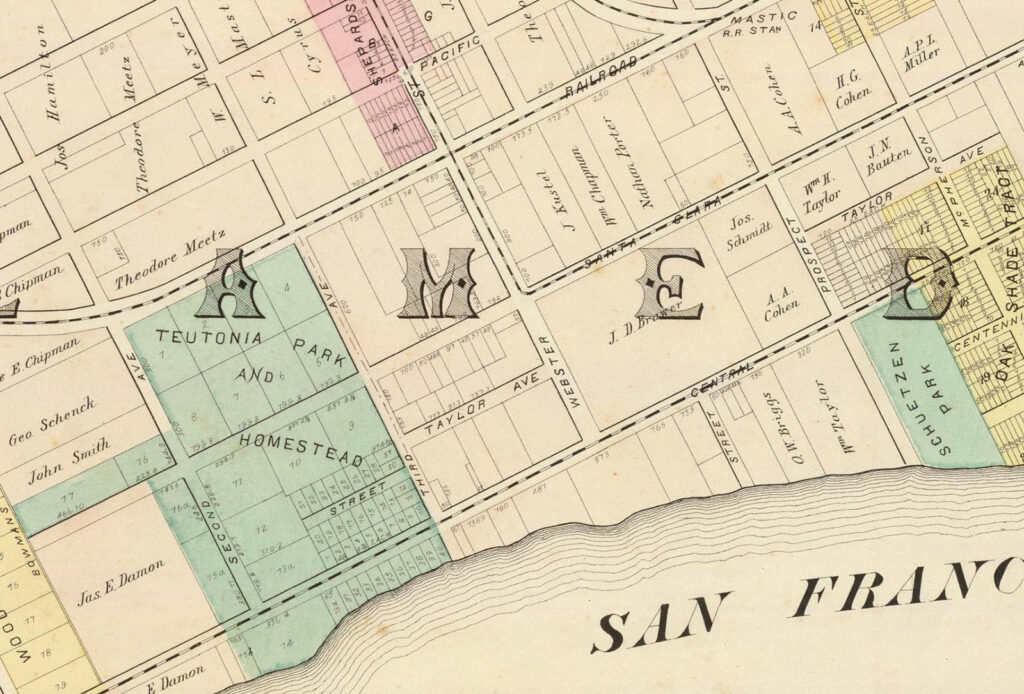Tour the architectural features around Taylor Avenue
For our next history walking tour, we are going to learn how to read a neighborhood. We’ll start at the Healing Garden at the corner of Taylor Avenue and Webster Street in Alameda’s West End and meander around the neighborhood. Along the way, we’ll have a close look at all the architectural styles and learn how to identify each one we see. Isn’t that one Queen Anne? How do you know that one is a bungalow? What’s the earliest style we can find? And the latest?

We won’t come across a single Arts and Crafts-style home. There’s no such thing. And we won’t see any Victorians. Not a single one exists in Alameda. We’ll see some towers, for sure. Will we see any turrets? We’ll come across some dentils, but will we see any quoins?
Join Alameda Post‘s Historian, Dennis Evanosky, for a walking tour of Taylor Avenue and Alameda’s West End as he sheds light on common questions, misconceptions, and queries about the area. As we always do, we will discuss the architectural styles of these homes and the history of the area. Meet at 10 a.m. on Saturday, June 17, or Sunday, June 25, at the Healing Garden at the corner of Taylor Avenue and Webster Street. Tickets are $20 in advance, and a limited number may be available at the start of each tour. Visit our Tours page for more information.
There are homes built in seven Victorian-era styles. Each blossomed and faded during Queen Victoria’s reign from 1837 to 1901. Alameda’s examples begin with the Greek Revival and end with the Craftsman style. The Victorian-era styles, in chronological order, are:
- Greek Revival
- Gothic Revival
- Italianate
- Eastlake (at first called Modern, then later Stick)
- Queen Anne
- Colonial Revival
- Craftsman
By the time we’re finished with our walk, you will be able to talk about all the different Victorian-era styles of homes. You’ll know at least three features of each style. We’ll no doubt come across a jerkinhead roof or two and too many naked protruding beams to count. What’s the difference between a column and a pillar? Is that column fluted? What kind of order defines the column? Ionic? Or is that Doric?

We’ll also talk about the lay of the land. Where was Euclid Street? What happened to it? Why are they called Taylor Avenue and Page Street?
What used to be down that street? A brewery? Why is that called Palace Street, anyway? Was there a palace on that street?
And Mackay Avenue? Who’s Mackay? Shouldn’t that be Mackay Street?
What happened to the movie theater on Central? It’s now a pizza place? Neptune’s Court and Neptune Gardens? How did they get those names?
Did three different trains really run here? And streetcars, both horse-drawn and electric? Where? Where did the marsh start?
And was there really an airport on Webster Street? And seven or eight baths along Central Avenue? What do you mean you couldn’t take a bath at home? Why is there all that water behind Paden School? Was there a bath there?
We’ll have fun answering all these questions and more. If you can’t join us on Saturday, June 17, we’ll repeat the same tour at the same place and time on Sunday, June 25.
Dennis Evanosky is the award-winning Historian of the Alameda Post. Reach him at [email protected]. His writing is collected at AlamedaPost.com/Dennis-Evanosky.



